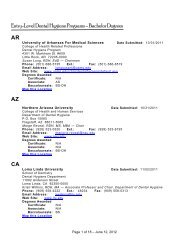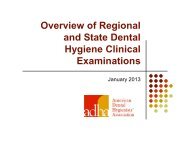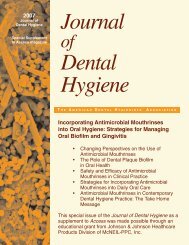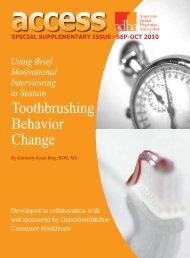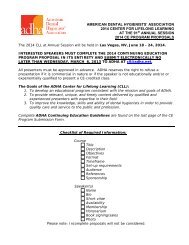Table I: Physiologic Rationale for Cardinal Signs of InflammationCardinal Signs of InflammationPhysiologic RationaleRubor (redness)Increased vascularityTumor (swelling)Exudation of fluidCalor (heat)Dolor (pain)Functio laesa (loss of function)A combination of increased blood flow <strong>and</strong> therelease of inflammatory mediatorsThe stretching of pain receptors <strong>and</strong> nerves bythe inflammatory exudates, <strong>and</strong> by the releaseof chemical mediatorsA combination of the above effectsMcMahon RFT, Sloan P. Essentials of pathology for dentistry. Edinburgh: Churchill Livingstone; 2000, p. 26.The inflammatory response consists of a vascular <strong>and</strong> a cellularreaction. These reactions are mediated by chemical factorsderived from plasma proteins or cells. The classic signs ofinflammation are redness, swelling, heat, pain <strong>and</strong> loss of function.The physiologic explanations for these signs appear inTable I. Other signs of inflammation include fever, leukocytosisor an increase in the number of circulating white blood cells,the presence of acute-phase proteins including C-reactive proteins(CRP), fibrinogen <strong>and</strong> serum amyloid A protein (SAA),<strong>and</strong> sepsis.There are two types of inflammation: acute <strong>and</strong> chronic.Acute inflammation is characterized by a rapid onset <strong>and</strong> shortduration. It manifests with exudation of fluid <strong>and</strong> plasma proteins,<strong>and</strong> emigration of leukocytes, most notably neutrophils.Chronic inflammation is of prolonged duration <strong>and</strong> manifestshistologically by the presence of lymphocytes <strong>and</strong> macrophages<strong>and</strong> results in fibrosis <strong>and</strong> tissue necrosis. When inflammationcontinues for prolonged periods of time, it can be thought of asthe healing process in overdrive, <strong>and</strong> deleterious changes canoccur to localized tissues as well as the entire body.In appreciating the inflammatory process, it is important tounderst<strong>and</strong> the role of chemical mediators. These are the substancesthat tend to direct the inflammatory response. Theseinflammatory mediators come from plasma proteins or cellsincluding mast cells, platelets, neutrophils <strong>and</strong> monocytes/macrophages.They are triggered by bacterial products or host proteins.Chemical mediators bind to specific receptors on target cells <strong>and</strong>can increase vascular permeability <strong>and</strong> neutrophil chemotaxis,stimulate smooth muscle contraction, have direct enzymatic activity,induce pain or mediate oxidative damage. Most mediators areshort-lived but cause harmful effects. 1 Examples of chemicalmediators include vasoactive amines (histamine, serotonin),arachadonic acids (prostagl<strong>and</strong>ins, leukotrienes) <strong>and</strong> cytokines(tumor necrosis factor <strong>and</strong> interleukin–1).Inflammation <strong>and</strong> <strong>Oral</strong> <strong>Health</strong>The inflammatory process significantly affects the periodontium.Plaque biofilm releases a variety of biologicallyactive products as gram-positive <strong>and</strong> gram-negative bacteriacolonize the tooth surface around the gingival margin <strong>and</strong>interproximal areas. These products include endotoxins,cytokines <strong>and</strong> protein toxins. 2 These molecules penetrate thegingival epithelium <strong>and</strong> initiate a host response that eventuallyresults in gingivitis. Evidence of this can be seen clinically withchanges in tissue color from pink to red, swelling, <strong>and</strong> bleedingupon probing. 3 Because gingivitis is typically not painful, itmay remain untreated for years. Worse, it may be viewed bypractitioners as something that requires less concern than periodontitis.Nevertheless, chronic gingivitis that persists for yearsmay provide the basis for greater concern for systemic healththan a periodontitis condition that is more readily treated.As the biofilm continues to proliferate, soluble compoundspenetrate the sulcular epithelium. This, in turn, signals the gingivalepithelium to produce chemical mediators includinginterleukin–1 beta (IL-1‚), prostagl<strong>and</strong>ins, tumor necrosis factoralpha (TNF-α), <strong>and</strong> matrix metalloproteinases. 4 Theseproducts recruit neutrophils to the area <strong>and</strong> influence chemotaxis,<strong>and</strong> can cause increased permeability of gingival vesselsthat permits plasma proteins to emigrate from the blood vesselsinto the tissue. As the inflammatory process progresses, additionalmediators are produced, <strong>and</strong> more cell types are recruitedto the area including neutrophils, T-cells, <strong>and</strong> monocytes.Continued inflammation results in signaling of fibroblasts <strong>and</strong>production of proinflammatory cytokines in the tissues.Antibodies specific to oral bacteria circulate in the peripheralblood. The acute-phase response becomes activated <strong>and</strong> CRP,fibrinogen <strong>and</strong> complement are produced both by local cells<strong>and</strong> within the liver. 5,6 These proteins may further exacerbate2 access—special supplemental issue—april 2006
Figure 1: Mediators <strong>and</strong> cells present in established gingivitisFrom: Scannapieco, FA: Periodontal inflammation: from gingivitis to systemic disease?Compend Cont Educ Dent. 2004; 25(7) (Suppl1): 16-24.the local inflammatory response <strong>and</strong> may affect the initiation orprogression of systemic disease (i.e., atherosclerosis). 7,8 Thisprocess of chronic gingivitis is represented in Figure 1.It is important to note that even though an individual mayhave established or chronic gingivitis, the condition is stillreversible. Thorough dental hygiene debridement <strong>and</strong> regularhome oral hygiene care could return the gingival tissues to astate of health. In some individuals when the inflammatoryprocess continues <strong>and</strong> exp<strong>and</strong>s, the collagen of the periodontalligament breaks down <strong>and</strong> bone resorption occurs, thus resultingin periodontitis. Individuals with periodontitis have thesame increased levels of proinflammatory mediators as thosewith chronic gingivitis, including CRP, fibrinogen, <strong>and</strong> IL-1‚<strong>and</strong> 6. Fortunately, when periodontal treatment is performed<strong>and</strong> clinical inflammation decreases, the serum levels of theseinflammatory mediators also decrease. 9The <strong>Oral</strong>-<strong>Systemic</strong> <strong>Relationship</strong>Although periodontal diseases are well known as an oralproblem, in the past decade, there has been a shift in perspective.Research has been focusing on the potential impact ofperiodontal diseases on systemic health. The relationshipbetween periodontal inflammatory disease <strong>and</strong> systemic diseasessuch as cardiovascular disease, diabetes, respiratory disease<strong>and</strong> adverse pregnancy outcomes has beenclosely investigated. The basis for the biologicalmechanism of this relationship isbeginning to emerge <strong>and</strong> further studymay lead to an underst<strong>and</strong>ing of whetheror not a true causal relationship exists.Cardiovascular disease (CVD) ischaracterized by the build-up of inflammatoryplaques that may cause thromboses<strong>and</strong> eventual myocardial infarction.Atherosclerosis is the term used for thethickening <strong>and</strong> hardening of the arteriesthat is produced by this plaque build-up.It represents a chronic inflammatoryresponse that causes injury to the endotheliumof elastic <strong>and</strong> muscular arterial tissue.One of the hallmarks of the early atheroscleroticlesion is the presence of neutrophilsfollowed by monocytes <strong>and</strong> lymphocytes.10 These leukocytes can affect thevascular endothelial lining <strong>and</strong> can causeoxidation of low-density lipoprotein(LDL) levels. Monocytes are induced tobecome macrophages, which take upmodified lipoproteins <strong>and</strong> become lipidladen“foam cells.” 11 The local inflammationis sustained by secreting chemicalmediators, <strong>and</strong> the atherosclerotic lesionbegins to bulge within the luminal wall.As this lesion progresses, the extracellularmatrix is degraded by proteolytic enzymes<strong>and</strong> becomes susceptible to rupture. Thromboses can occur,occluding blood flow to the heart, which may eventually leadto infarction.Since atherosclerosis is considered to be inflammatory innature, identifying inflammatory markers that correlate withdisease state is beneficial. One of the most recognized <strong>and</strong> consistentmarkers of systemic inflammation <strong>and</strong> poor cardiovascularprognosis is the acute-Cardiovascular disease(CVD) is characterized bythe build-up ofinflammatory plaquesthat may causethromboses <strong>and</strong> eventualmyocardial infarction.phase protein CRP. 12,13 It isproduced by the liver <strong>and</strong>released into the blood stream.It is positively correlated to IL-6, activates complement <strong>and</strong>accounts for LDL uptake bymacrophages. 14-16It has been proposed thatbacteria or viruses may directlyinfect atherosclerotic lesionscontributing to the inflammatoryprocess. Further, distant infections may increase systemicinflammation through the release of toxins or the leakage ofchemical mediators into the circulation. 17 It has been reportedthat studies of atheromatous lesions in the carotid arteries havefound over 40% of atheromas contain antigens from periodontalpathogens including Porphyromonas gingivalis, Tannerellaforsythensis, <strong>and</strong> Prevotella intermedia. 18 In addition, P. gingi-special supplemental issue—april 2006—access 3





